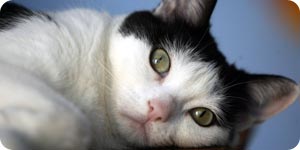
Feline constipation is not uncommon, and while it is more often found in older cats, it can occur in cats of any age. Generally, a cat will have one or two bowel movements a day. A change in this pattern could indicate that the cat is suffering from constipation. This article covers some information that can help you identify and treat this health problem.
Symptoms
- Loss of Appetite – A cat suffering from constipation will usually be less interested in food. It may have an upset stomach and no desire to eat at all, or it will eat much less than normal.
- Frequent Trips to the Litter Box – When a cat is constipated, it will feel the urge to use its litter box, but will be unable to pass stool. The cat may spend more time than usual in its box but there won’t be any evidence of waste. You may also find a small amount of diarrhea that may even have a slightly bloody tinge.
- Lethargy – You may notice that the cat will find a quiet place to sleep and be less social.
There are three types of constipation, and treatment will vary depending on the specific type from which the cat suffers. The three types are as follows:
- Constipation -This is the general term for the condition where the animal is unable to pass a complete bowel movement or does so with great difficulty.
- Obstipation – This situation is where the cat’s colon is blocked and is unable to pass a bowel movement.
- Megacolon – This condition is the most extreme of the three and involves a loss of movement in the muscles of the walls of the colon. This is normally a direct result of constipation or obstipation, but can occur when fecal matter stays in the colon and builds up, blocking the passageway.
Causes
This condition can occur naturally, but usually it is the result of other factors. Here are some of the most common causes:
- Dehydration – Water is an essential component of a cat’s diet. A lack of water can lead to a hardening of the stools and difficulty defecating. This, in turn, can cause the cat to become constipated.
- Diet – Cats need a balanced diet, and should never be fed human food. Rich, fatty or salty foods can dehydrate a cat. Cats can also become constipated by eating bones or other animals, or even hair. Watch your cat’s weight, as well. Overweight cats tend to suffer more from this condition.
- Hygiene – Believe it or not, a cat may avoid using a dirty litter box, and, being a creature of habit, will try to hold a bowel movement rather than use a dirty box. This can lead to a build up of fecal matter in the colon, which will harden, causing constipation. Be careful when you change brands of cat litter. Some finicky cats will actually refuse to use the box if they don’t like the type of litter!
- Other Factors – Lack of exercise can lead to constipation as can stress, other illness, or infections in the anal area. Tumors can also cause an inability for a cat to pass stool.
Treatment
Before your cat can be treated, the veterinarian must first determine the severity of the condition and whether or not damage to the colon has occurred. The level of hydration must be checked, and generally blood and urine tests are required to determine whether there is something more serious causing the condition. Sometimes, an X-ray is required to determine whether there is a blockage or even a foreign object in the colon.
Treatment depends on the severity of the condition, but generally involves hydrating the cat. Intravenous hydration may be required. An enema may also be needed. In some cases, the cat will have to be anesthetized so that hardened stool can be removed from the colon. In severe cases, surgery may be required to remove part of the colon.
Once the cat has been treated and is back home, make sure that it has plenty of fresh water. Feed the cat moist, canned food rather than dry. Ease it back into a mixture of dry and moist food. Some veterinarians will recommend adding fiber to the cat’s diet in the form of bran or an over-the-counter product such as Metamucil.
